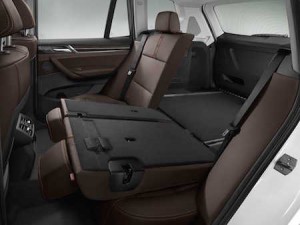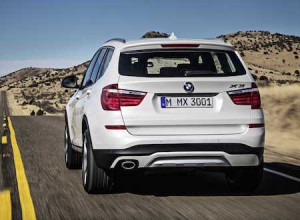 The sales chart for SUVs, 4x4s, Crossovers, call them what you will, is at its highest sales level ever.
The sales chart for SUVs, 4x4s, Crossovers, call them what you will, is at its highest sales level ever.
The latest BMW X3 five-door, five-seater range is priced from £31,295 for the new 18d SE in a two wheel drive configuration or from £33,295 for the 20d with their xLine 4×4 traction and it is their best selling version. Both have 2.0-litre turbodiesel engines.
Top of the range is the 3.0-litre, 35d xDrive model with its standard-fit sports eight-speed standard automatic transmission with M Sport specification and priced at £46,690. All versions use BMW’s EfficientDynamics technology which includes auto start-stop, brake energy regeneration and for manual gearbox versions optimum shift gearchange indicator points.
In its premium area of the sector the X3 does battle with the Range Rover Evoque, the Audi Q5, Volvo XC60, the new Lexus NX 300h and the all new Land Rover Discovery Sport. The elephant in the room in this sector, where business users account for a high proportion of UK sales, is the tax-busting plug-in petrol/electric/hybrid Mitsubishi Outlander. Although not a premium brand contender it has become a significant choice because of its low CO2 emissions and relatively tiny Benefit-in-Kind company car tax implications.
Although the sales leader in this sector is the Range Rover Evoque and the new Land Rover Discovery Sport is expected to match its stablemate, the BMW X3 is reckoned to be the best overall in terms of its classy image, on-road handling, roomy interior and it’s good to drive.
Off-road it is capable but cannot compete when the going gets tough with the Evoque or the Disco Sport but on road the X3 in two or four wheel drive configurations is better than all its competitors. The Audi Q5 probably has a nicer quality interior and the Disco Sport offers seven seats but overall the X3 is still top-dog in this pack of SUVs.
 The latest BMW X3 models have received a new generation of high-torque turbodiesel engines ranging from 18d 150hp to 20d 190hp to 30d 258hp and 35d 313hp. CO2 emissions range from 124 to 157g/km and fuel economy from 60.1 to 47.1mpg. The 18d is what they call sDrive which is front wheel drive only, the rest of the engines are mated with xDrive all wheel drive traction.
The latest BMW X3 models have received a new generation of high-torque turbodiesel engines ranging from 18d 150hp to 20d 190hp to 30d 258hp and 35d 313hp. CO2 emissions range from 124 to 157g/km and fuel economy from 60.1 to 47.1mpg. The 18d is what they call sDrive which is front wheel drive only, the rest of the engines are mated with xDrive all wheel drive traction.
Other changes include exterior styling, an improved level of standard interior specification and an additional xLine level of specification, depending on the engine chosen, joins the traditional SE and M Sport variants.
With regards to the exterior styling, those most likely to see the differences are existing X3 owners. At a casual glance it looks much the same and so it retains its significant road presence with its chunky and muscular five -door layout. At the front are new twin-circular headlights, a new surround for the traditional BMW kidney grille, both front and rear bumpers gain new contours while the LED supplementary indicators are now housed in the new exterior door mirrors. There are four new body colours and new light-alloy wheel designs.
Inside the tweaks include new trim combinations, new cup holders with a sliding cover in the centre console and a leather steering wheel is now standard. The interior remains classy and somewhat understated although the Audi competitors probably have the edge in visual quality. But the X3 has better laid out controls including the excellent and easy to use rotary iDrive controller.
Needless to say there is a massive array of extra cost options which will add significantly to the price but personalisation is a major requirement by customers in most sectors these days. The X3 continues to be the roomiest in its class with boot space to match with 550-litres with the split rear seats in use which goes up to 1,600-litres with the seats folded.
 I have just refreshed my BMW X3 driving experience in the top of the range xDrive 35d M Sport variant which weighed in with a hefty £46,690 price tag but with a whole list of options pushing up the price to £51,170. Some of these should be standard at this top of the range level.
I have just refreshed my BMW X3 driving experience in the top of the range xDrive 35d M Sport variant which weighed in with a hefty £46,690 price tag but with a whole list of options pushing up the price to £51,170. Some of these should be standard at this top of the range level.
A Media Package including upgraded BMW Professional Navigation including real-time traffic information and on-line services costs £900 and a Visibility Package with headlight washers, Xenon headlights, adaptive headlights and LED fog lights plus high-beam assist adds a further £1,105 to the price.
The most desirable item – Variable Damper Control to adjust the suspension ride comfort and performance adds another £650, a panoramic sunroof costs £1,190 and even the Head Up display is charged for at £895.
The model I tried is the flagship of the range, not my usual choice, but the one available at the time. With its 3.0-litre, straight-six, turbodiesel now up to Euro 6 emissions standards, it now pushes out 313hp. More important than the power is the huge torque output of 630Nm from just 1,500rpm. It really did show just how good the X3 is for its on-road eager and responsive performance. Mated with the xDrive system and the variable power distribution to each wheel as required resulted in immense cornering grip.
With its standard fit eight-speed sports automatic gearbox acceleration is immediate and delivered smoothly. At much slower speeds dawdling in traffic and stop and start driving, which have become a main feature of our congested roads, the engine can be as docile and smooth or it can easily be ferocious when needed.
 Overall the X3 – the King of the mid-sized premium brand SUVs, retains its crown for 2015.
Overall the X3 – the King of the mid-sized premium brand SUVs, retains its crown for 2015.
But the competition is getting stronger especially with the arrival of the new seven-seat Discovery Sport. Also all-new generation models from other manufacturers are making more use of hybrid technology to reduce emissions and tax costs and yet improve performance.
BMW has it in other models so next time around the X3 will need more significant changes to retain its crown.
Milestones:
BMW X3 35d xDrive M Sport 5-Door SUV. Price £46,690, as tested £51,170.
Engine/transmission: 3.0-litre, in-line 6-cylinder, turbodiesel, Euro 6 compliant, 313hp, 630Nm of torque from 1,500rpm, 8-speed sports automatic transmission with xDrive 4×4 variable drive output to each wheel. Performance: 152mph, 0-62mph 5.3-seconds, 47.1mpg Combined Cycle (35.3mpg on test), CO2 157g/km, VED road tax £180, BIK company car tax 27% now and 29% from April.
Insurance: Group 43.
Warranty: 3-years/unlimited mileage.
Dimensions/capacities: L 4,657mm, W 1,881mm, H 1,678mm boot/load space 550 to 1,600-litres, braked towing weight 2,400kg.
For: Still highly rated, a classy premium brand SUV, clever 4×4 system for on-road use with some off-road ability, good to drive, roomy, excellent infotainment system and easy to use iDrive controller.
Against: At this price there are too many extra cost options that should be standard like variable dampers, interior not as plush as an Audi Q5, large wheels and wide tyres give unsettled directional stability over tram-lined road surfaces, needs more hybrid technology to match other lower CO2 emitting newcomers to the sector.

